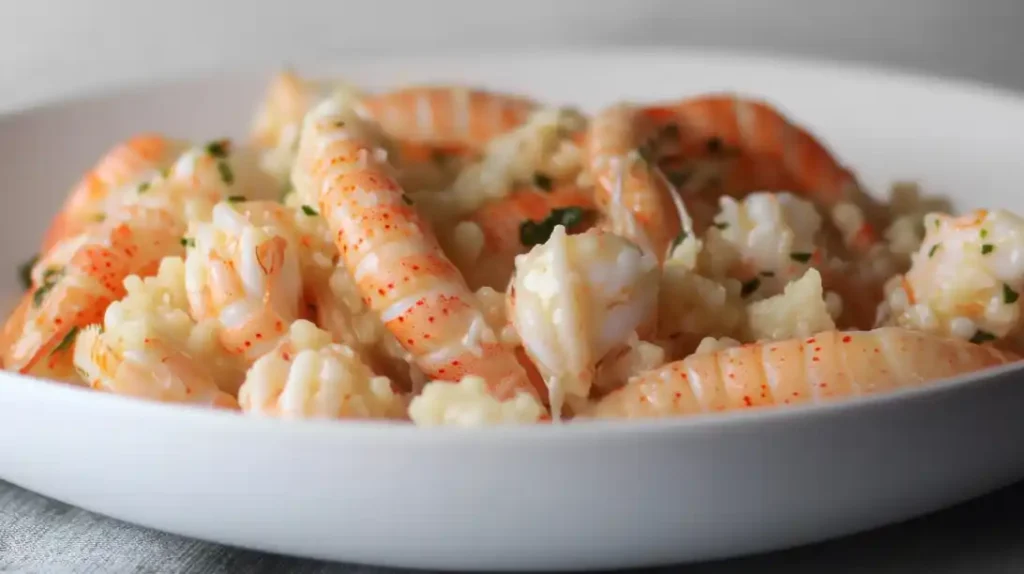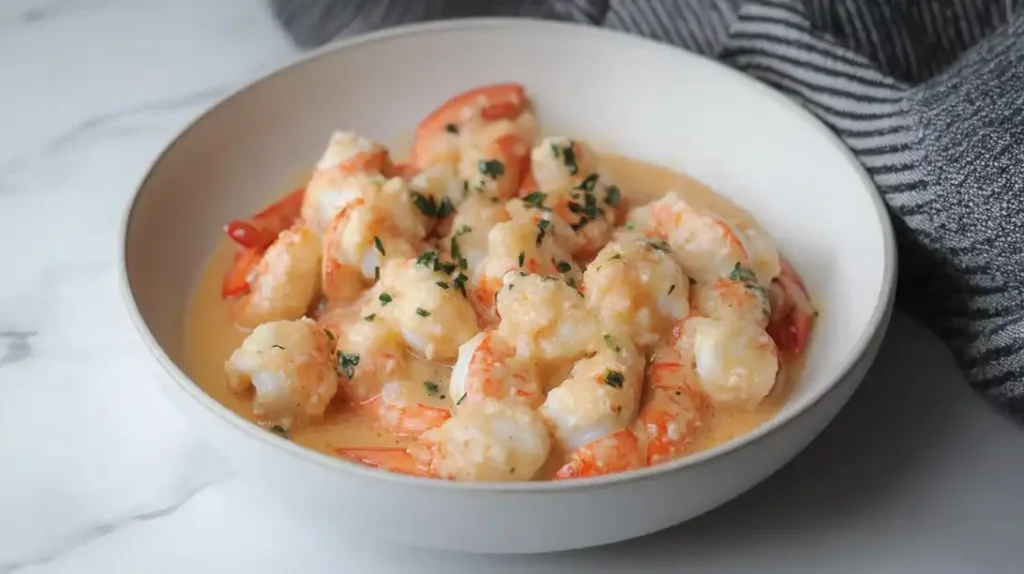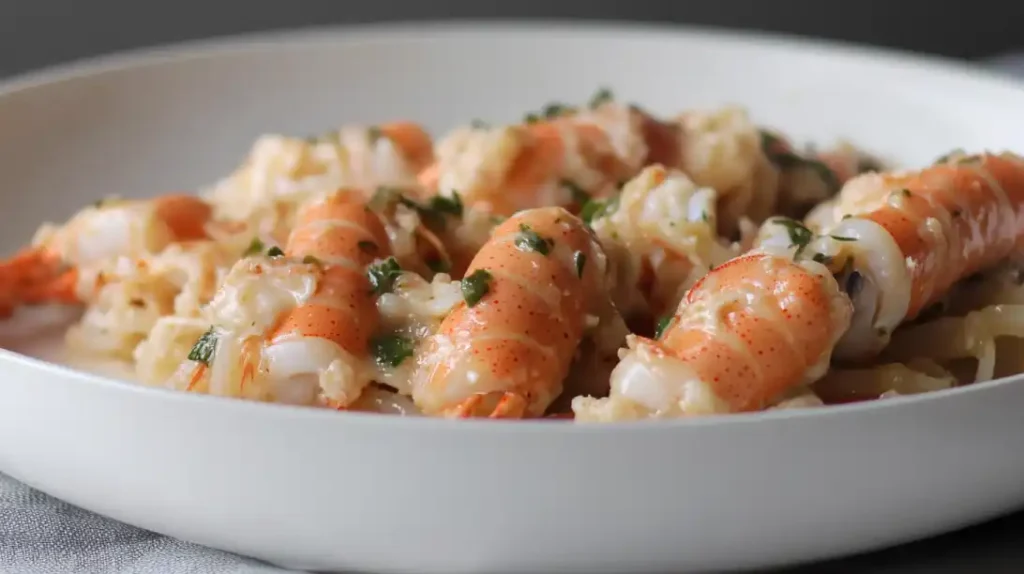Want to learn more about perfect seafood grilling? Explore the Yuan Yaki grilling technique to elevate your cooking.
Table of Contents
What Are Langostino Tails?
Langostino tails are the meat from small shellfish, typically from species like squat lobsters or certain kinds of crabs. Despite their resemblance to lobster in both texture and taste, they come from a completely different crustacean family. These tiny tails are loved for their delicate, sweet flavor, perfect for seafood lovers looking to try new dishes such as this salmon stew recipe.
Are Langostino Tails the Same as Lobster Tails?
Nope, they’re not the same! While they taste similar to lobster, langostino tails come from smaller shellfish. Think of them as the perfect alternative if you’re looking for lobster flavor at a fraction of the price.
Nutritional Value
Langostino tails aren’t just tasty; they’re also quite healthy! Here’s what you’ll typically get per 100 grams of cooked langostino tails:
| Nutrient | Amount (per 100g) |
|---|---|
| Calories | ~90 kcal |
| Protein | 19g |
| Fat | 0.9g |
| Omega-3 | 200mg |
| Cholesterol | 60mg |
Langostino is low in fat but rich in protein, making it a great addition to any balanced diet.
Top Health Benefits of Langostino Tails
- High in Protein: Great for muscle repair and overall body health.
- Low in Calories: Perfect for weight-conscious eaters.
- Rich in Omega-3s: Helps support heart health and brain function.
- Low in Fat: Unlike some other seafood options, langostino tails are lean and light.

How to Buy Fresh Langostino Tails
When shopping for langostino tails, freshness is key. Here’s what to look for:
- Firm Texture: The meat should feel firm, not mushy.
- Bright Color: Avoid tails with a dull or grayish tint.
- Minimal Odor: A fresh langostino should smell slightly briny, like the ocean—not fishy!
Best Ways to Cook Langostino Tails
There are several ways to prepare langostino tails, depending on your taste. Here are a few popular methods:
Sautéed Langostino Tails
Heat some butter and garlic in a pan. Toss in the langostino tails for about 3-4 minutes until heated through. For a similar dish, check out the shrimp with garlic butter recipe.
Langostino Alfredo Pasta
Prepare a creamy Alfredo sauce. Cook the pasta of your choice and add sautéed langostino tails to the mix. Top with grated Parmesan and serve hot.
Grilled Langostino Skewers
Marinate the tails with olive oil, lemon, and herbs. Skewer them and grill on medium heat for 2-3 minutes per side. Looking for more seafood grilling tips? Visit King Salmon Recipes for grilling ideas and sustainability information.
Pro Tips for Cooking Langostino Tails
- Don’t Overcook: Langostino meat is delicate; it can turn rubbery if cooked for too long.
- Season Lightly: The natural sweetness of langostino tails shines with simple seasoning like salt, pepper, and lemon.
- Pair with Bold Flavors: Langostino pairs well with garlic, butter, and creamy sauces.
Langostino Tails Recipe: Garlic Butter Delight
Here’s a quick and easy recipe for buttery langostino tails:
Ingredients:
- 1 pound langostino tails
- 4 tablespoons butter
- 3 cloves garlic (minced)
- 1 tablespoon lemon juice
- Fresh parsley (chopped)
Instructions:
- Melt the butter in a large skillet over medium heat.
- Add the minced garlic and sauté for 1-2 minutes.
- Toss in the langostino tails and cook until heated through (around 3-4 minutes).
- Remove from heat, add lemon juice, and garnish with parsley.
- Serve with crusty bread or over rice.

Common Mistakes to Avoid When Cooking Langostino Tails
- Overcooking: This is a surefire way to ruin the texture.
- Not Thawing Properly: If using frozen tails, thaw them slowly in the fridge to retain moisture.
- Too Much Seasoning: Let the natural flavor of the langostino shine.
How to Store and Reheat Langostino Tails
- Refrigeration: Store cooked langostino tails in an airtight container for up to 3 days.
- Freezing: You can freeze cooked langostino tails, but it’s best to use them within 1-2 months.
- Reheating: Warm them gently in a skillet with a little butter to avoid drying them out.
Creative Serving Ideas for Langostino Tails
Looking to get creative with langostino tails? Here are some fun and delicious ways to serve them:
1. Langostino Tacos
- Use soft tortillas.
- Fill them with seasoned langostino tails, shredded cabbage, avocado slices, and a drizzle of spicy mayo. Learn more about taco inspiration with this rolled tacos guide.
2. Langostino Rolls
- Think lobster roll, but with langostino!
- Toss the tails in a light mayo dressing with lemon and herbs, then serve in toasted buttered rolls.
3. Langostino Pizza
- Use a thin-crust pizza base.
- Spread garlic cream sauce, mozzarella, and cooked langostino tails on top.
- Add fresh basil after baking for a gourmet seafood pizza.
4. Langostino Salad
- Toss the tails with fresh greens, cherry tomatoes, cucumbers, and avocado.
- Dress with a lemon vinaigrette for a light and refreshing option.
What Does Langostino Taste Like?
Langostino has a sweet, delicate taste, similar to lobster but slightly less rich. Its texture is firm yet tender, making it an excellent addition to a variety of dishes. Many people describe it as a cross between shrimp and crab but with a unique flavor of its own.
Langostino Tails vs. Shrimp: What’s the Difference?
Though langostino tails may look a bit like large shrimp, they’re quite different in flavor and texture. Shrimp tends to have a slightly firmer, chewier bite, while langostino is more tender and buttery. When it comes to taste, langostino leans more towards lobster with a naturally sweet flavor.
Sustainability of Langostino Fishing
Langostino tails are often considered a more sustainable option than lobster or other large crustaceans. Many langostino fisheries implement eco-friendly practices to ensure healthy populations and minimal impact on marine ecosystems. This makes them a great choice if you’re looking to eat more sustainably.
The History of Langostino in Cuisine
Langostino has been a beloved seafood ingredient in many cultures, especially in Mediterranean and South American cuisines. It has only recently gained popularity in North American kitchens, thanks to its affordability and versatility compared to lobster. Today, it’s featured on menus ranging from fine dining establishments to casual seafood shacks.
Pairing Langostino Tails with Wine
Wondering what wine pairs best with langostino tails? Here are a few options that complement their sweet, buttery flavor:
- Chardonnay: Its creamy notes highlight the richness of buttered langostino dishes.
- Sauvignon Blanc: A crisp, citrusy Sauvignon Blanc balances out lighter dishes like langostino salads.
- Rosé: Perfect for langostino tacos or rolls, adding a refreshing and fruity touch.
Langostino Tails for Meal Prepping
Langostino tails can be a lifesaver for meal prepping. Since they cook quickly, you can prepare them in bulk and use them throughout the week. Here are some ideas:
- Over Rice Bowls: Serve langostino tails with brown rice, steamed veggies, and a light soy glaze.
- In Pasta: Add them to pre-cooked pasta with olive oil, garlic, and parmesan.
- Seafood Stir-Fry: Toss them into a quick stir-fry with bell peppers, onions, and teriyaki sauce.
Langostino Tails in Global Cuisine
Langostino is used in many traditional recipes around the world. Here are a few examples:
Spain:
- Paella de Mariscos – A seafood paella that sometimes includes langostino for added flavor.
Chile:
- Caldillo de Mariscos – A rich seafood stew featuring langostino along with fish and clams.
Italy:
- Risotto ai Frutti di Mare – A creamy seafood risotto that often incorporates langostino tails.
Common Myths About Langostino Tails
Let’s clear up some common misconceptions:
- Myth #1: Langostino is just a small lobster.
- Truth: Langostino comes from a different species entirely, although it has a similar flavor profile to lobster.
- Myth #2: Langostino is hard to cook.
- Truth: It’s actually one of the easiest seafood options to prepare! Most recipes take under 10 minutes.
- Myth #3: Langostino tails have no nutritional value.
- Truth: They’re packed with protein, omega-3s, and essential minerals.
Tips for Hosting a Langostino-Themed Dinner Party
Planning a seafood night? Here’s how to impress your guests with a langostino-focused menu:
- Appetizer: Langostino ceviche with lime, cilantro, and red onion.
- Main Course: Grilled langostino tails with garlic butter, served with rice pilaf.
- Dessert: Lemon tart to balance out the richness of the main course.
- Drinks: Offer a crisp white wine or a light, citrusy cocktail.

FAQs
Q1: Can you eat langostino tails raw?
No, langostino tails should be cooked before eating to ensure safety and the best flavor.
Q2: Are langostino tails high in cholesterol?
While they do contain cholesterol, they’re low in fat and provide heart-healthy omega-3 fatty acids.
Q3: How long do langostino tails take to cook?
Langostino tails usually cook in 3-5 minutes, making them one of the fastest seafood options to prepare.
Q4: Can I use langostino tails as a substitute for lobster?
Absolutely! Langostino tails are an excellent, budget-friendly alternative to lobster in most recipes.
Conclusion
Langostino tails may be small, but they pack a serious punch when it comes to flavor, nutrition, and versatility. Whether you’re sautéing them in garlic butter or tossing them into a seafood pasta, these little tails offer a gourmet experience without breaking the bank. So the next time you’re craving seafood, skip the lobster and give langostino a try—you won’t be disappointed!

